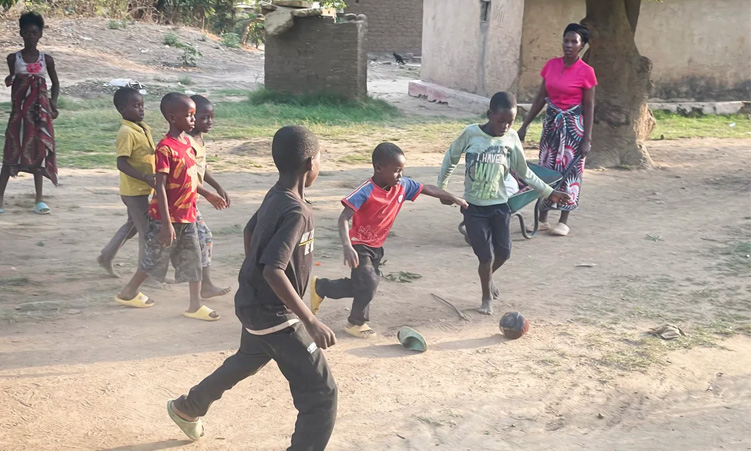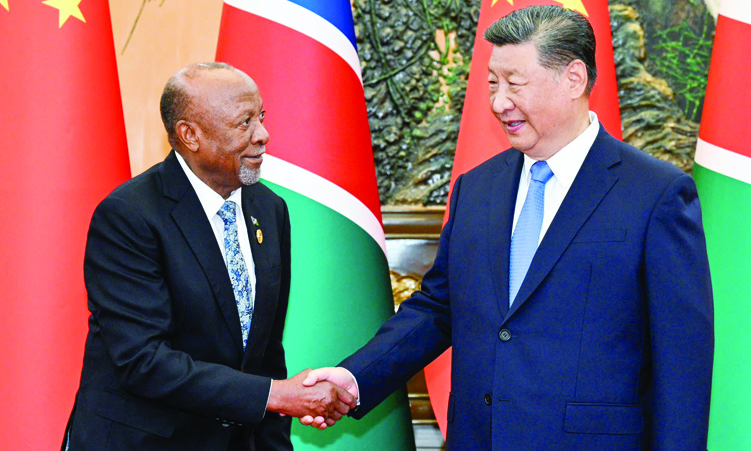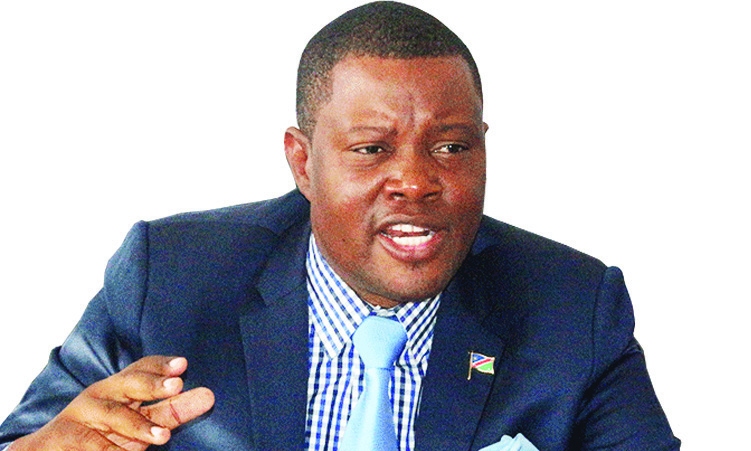The toxic legacy of a century-old lead mine in Kabwe, Zambia, is still poisoning children. A years-old class action suit on their behalf has moved to the Supreme Court of Appeal. Hamilton Wende went to Kabwe to film a documentary for Al Jazeera and reflects on the legal, moral and humanitarian dilemmas surrounding these children and their ongoing suffering.
The morning sun breaks through the spindly African hedgerows and dapples the dusty road. A mother and her son are walking hand in hand along the roadway. He is dressed in his school uniform – a neatly pressed blue shirt and grey flannel trousers. She is wearing a pink T-shirt and a blue-and-yellow wrap skirt.
Their pace is slow, deliberate, as the mother makes allowances for her son’s distracted progress. He ambles and stops to look around him, staring intently at the greenery or, sometimes, up at the sky.
His mother cajoles him along the dusty streets of Kabwe, the capital of Zambia’s Central Province that was called Broken Hill in colonial times. They are already late for school, but her son doesn’t care. His is a peripheral existence, partly engaged in the world around him; partly uncertain of its boundaries that define so much of the way the rest of us see our lives, and those we share them with. We know them when we encounter them, but this child doesn’t easily recognise their limits, or understand when he is approaching their threshold.
This slow, hesitant walk under his mother, Diana’s, care is the best the boy, Sashi, can do this morning – the best he can do every morning. He is suffering from damaging lead exposure from birth, and it has affected his development. He is seven years old, but he has the mental capacity of a much younger child.
His sister, Gift, is four, but seems to be doing better. Diana tells me about Sashi, about whom she worries constantly.
“The one who has it badly is this one. You tell him something, he doesn’t pay attention. Even at school the reports are not okay. He isn’t making any progress, misbehaving and playing in the dirt. When you send him to fetch something he won’t refuse, but will just bring something else instead. He brings something else then starts throwing stones at his friends. It was then I realised the lead poisoning is still affecting him.”

Professor Jack Caravanos, a global environmental health expert at New York University, has been studying areas of contamination for years. He calls Kabwe one of the world’s “sacrifice zones” – a place of toxicity largely forgotten by the world.
“Over the years I’ve been to many sacrifice zones in just about every and all continents, but the one that is most serious in my 40 years of doing this, is the one in Kabwe.
“When I got there and took some initial measurements we found very, very, high levels (of lead) in over 85% of the children in Kabwe. This was about 200 children in the zone around the mine who had blood lead levels above 45 (milligrams per 100 millilitres). The number of 45 in the US would put a child in the hospital. I was shocked, The instrument we use peaks out at 60. We had many kids with a level of 60 plus, and that was the highest I’ve ever seen in my career.”
According to the World Health Organization (WHO) there is no safe level of lead in the blood, while a recent study in the Lancet Planetary Health journal found that not only does lead contamination lead to serious drops in IQ levels in children, it also contributes to death from heart disease in adults.
These dangerously high lead levels have been here in the soil for more than a century. The first lead-zinc-silver mine was opened in Zambia in 1906 and mining continued until 1994. During the most productive years of its life, from 1925 to 1974, when the mine was nationalised by the Zambian government, it was operated by the Rhodesia Broken Hill Development Corporation in which Anglo American was a minority shareholder.
After Zambia’s independence, the mine was operated by Zambia Consolidated Copper Mines until it was closed in 1994.
‘Not responsible for the lead contamination’
Anglo claims it provided certain services to the mine but at no point owned or operated the mine, and says it is not responsible for the lead contamination that it does not dispute is present.
Diana and Sashi arrive, and Sashi finds his way inside the school buildings. In the classroom among the rows of eager kids, Sashi sits placidly, both unbothered and, sadly, largely uninvolved. He looks around vaguely while other children shout out the answers to teacher Mildred Mulenga’s questions.
Mulenga wears a dark floral dress, and clearly has tremendous patience. She writes on the green expanse of the board with chalk and does her best to elicit responses from her pupils.
After class she talks to me: “We have a problem with our learners; most of them have got memory loss. When you teach, especially sums, they usually forget. I think it’s from lead poisoning. Most of my learners here, they are affected. They will learn about something today. Tomorrow, you ask them, they will just look at you.”
I ask her about Sashi: “The boy has not been improving in learning. He’s very much behind. He performs as if he’s still in preschool.”
At break time red dust from the playground fills the air around the children’s milling feet.
Lead contamination is an invisible apocalypse, made manifest only when the trillions of motes of dust catch the sunlight, in the streets of the old colonial town at dusk, swirling upwards from the grass strands of a mother’s broom sweeping her yard, or as here kicked up by the calloused feet of children playing in the school yard.
This is not a new story. Generations of children like Sashi have been affected by the extremely high lead levels present in the soil since the mine began, but in October 2020, a class action lawsuit was filed in South Africa by 13 plaintiffs on behalf of an estimated 100,000 children and 40,000 women and girls whose pregnancies were at risk, against Anglo American for restitution as a result of lead contamination.
Crucial evidence
While Anglo claims it is not responsible for the lead contamination and the harm it has caused to many thousands of people over the decades, Zanele Mbuyisa, a partner at Mbuyisa Moleele, one of the two law firms representing the plaintiffs, points to a crucial piece of evidence that shows that Anglo was aware of significant, even widespread lead contamination while it was involved in the mine. Mbuyisa says it provided engineering, managerial, and secretarial services which “clearly show that they were in charge”.
“There’s the affidavit of Dr Ian Lawrence,” she says, “a young doctor who went to work at the mine hospital, and this was in late 1960s, early 1970s, and when he got there he immediately saw that there was a problem with the children, children dying.
“He wrote: ‘I became deeply concerned at the number of deaths among children under the age of five in their residential township, particularly of children between one and three years old.’”
Dr Lawrence went on to take blood samples of about 500 children under five from the township, and in early 1970 he received the results of the analysis.
“Virtually all were in excess of 40 micrograms of lead to 100 millilitres of blood, and many were in excess of 100 micrograms… the invariably high levels convinced me that the problem was very serious.”
He was so upset with these findings that at midday on a Saturday, he delivered the results of the tests to Chief Medical Officer, Dr Frances Smith, of whom Dr Lawrence says in his affidavit “I’m almost certain was employed by Anglo American”. So convinced was he that urgent action was needed that he could not wait until the following Monday.
“Within a short period of time,” he writes, “it was clear to me that the mine administration and the Anglo American office in Lusaka had received the report.”
According to the affidavit, soon after, two doctors from Manchester University arrived in Kabwe to review the report and investigate the situation. Neither expressed any disagreement with the findings. Apart from one brief informal discussion a few years later that Dr Lawrence had with a Dr Whitcombe, the Medical Director of the entire Anglo American group at the time, no one discussed Dr Lawrence’s report with him.
Follow-up reports
There were follow-up reports commissioned by the company from a Professor Lane and a Dr King that were mentioned in internal company correspondence. Recommendations were made to replace the topsoil with a new layer and relocate some of the houses, but these were rejected as being too expensive. In addition, a mine doctor, Dr ARL Clark, published an MD thesis in which between 1973 and 1974 he found that the blood lead levels of children in Kabwe were up to 20 times higher than those set by the US Centers for Disease Control.
In the township of Chowa, I visit 80-year-old Matthias Chatabankana. His house is a typical small old colonial brick structure with a stoep in front and a small kitchen stoep in back. He has lived here since 1982 with his wife Irene and their 10 children.
“But one of them passed away during childbirth,” he says sadly.
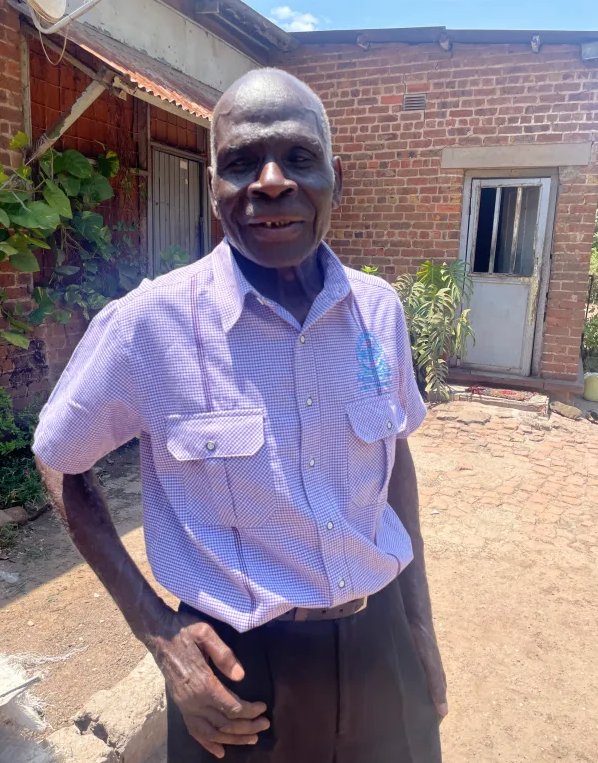
We sit under an old spreading tree in his simple garden, while he speaks of his life.
“These are the houses which were occupied by whites early when the mine started. Now because of the fumes from the mines, from the furnaces, these people were removed to a new township and the Africans were given these houses to stay here. So, we Africans remained here, swallowing the dust, swallowing the smoke. As a result, we are very badly affected with lead in our blood.
“The life of African miners here in Kabwe was not good. There was a lot of segregation. Africans on their own and whites on their own. And once you are employed and make just a simple mistake, you are slapped: ‘Stupid makaka (monkey) is this the shovel which I told you to bring?’ A slap goes in. And that man will go holding his cheek or his ear. Sometimes he goes crying.”
Chatabankana’s body language is that of a man made confident by his anger. He looks at me carefully as he speaks.
“Zambians were always in the forefront doing the work there, with maybe one white man who comes there to supervise you with a mask on his mouth; but you are working without protective clothes.”
He shakes his head at the memories.
“We were in darkness; we didn’t know anything – that lead is a serious poison to the human body.”
“Did you get sick?” I asked him. “Yes, I went to the hospital.” He points to a vein in his arm where they drew blood. “You’ve got a bit of lead (they told him). I couldn’t go anywhere; I was just a simple employee. But when a white man got sick with lead poisoning he was sent to South Africa for medical treatment.”
“Do you think Anglo did enough to prevent lead pollution?” I ask.
Anger fills his face, and he waves his hand dismissively.
‘We were used as tools’
“Nothing. No. What they wanted was just lead and zinc from the mine, and we were used as tongs, or tools, to produce that lead.”
He gestures across his patchy lawn.
“The dust is in anything you touch, it’s got lead. Anglo American just went and took their lead and zinc and all the money and went home.”
Anglo American declined an interview; and pointed us to their website, which reads:
“We have every sympathy for the people of Kabwe, the pollution the town experiences and any harm that may have come from it. Contamination is not acceptable anywhere.
“An attempt is being made to hold Anglo American South Africa liable for a mine we have never owned nor operated and for pollution and harm that others have caused and freely acknowledged as their responsibility. We do not believe it is correct for the claimants to attempt to attribute legal responsibility to Anglo American South Africa for the current situation in Kabwe.”
Richard Meeran, a senior lawyer for London-based Leigh Day, which is partnering with Mbuyisa Moleele in bringing the class action suit, says this argument is false: “The issue of Anglo’s shareholding or level of investment is a total red herring. It’s a complete irrelevance. Anglo’s legal responsibility is dependent on the role that they played, which affected control of lead emissions from the mine and surveillance of lead poisoning. Anglo completely failed.
“And it especially failed because its own mine doctors had drawn attention to massive contamination.”
To the non-legal observer, however, it seems Anglo has a point – narrow, legalistic, and deeply cynical and uncaring, as it certainly is, especially in the light of Dr Ian Lawrence’s unambiguous affidavit.
The mine was indeed nationalised in 1974 and control of the operations passed to the Zambian government. In the decades that followed, until and after the closure of the mine in 1994, there was very little done by any Zambian administration to remediate the harmful environment.
Efforts made
However, the new Zambian government, in power since 2021, has, at least, recognised the problem and has made some efforts, together with the World Bank help, to begin to mitigate the problem, following on from previous government attempts, but these have not been without their challenges
I put these challenges to Chrizoster Phiri Halwindi, the member of parliament for Kabwe Central.
“The government has done a lot. There’s a canal that we are cleaning up just to make sure there’s free flow of water. In certain areas, they will tend the soils. Then in certain areas, they will pave the yards just to protect children.”
She was reluctant to blame Anglo American, but she did point out that when they were mining, they must have known there would be environmental consequences. Kabwe, however, has always relied on mining for its economy so there were no easy solutions, she said.
“Simon” is one of those who has had to find a way to scratch a meagre living from the contaminated detritus of the mine that once made millions of dollars for its shareholders.
We meet him beneath the looming vast tailings dump that the locals call “Black Mountain”, a huge pile of waste that contains an estimated 6.5 million tons of old lead-contaminated rock and soil.
Simon is nervous. He is part of the illegal underworld that exists of bitter necessity because there is no other way for so many, particularly men, here to earn a living.
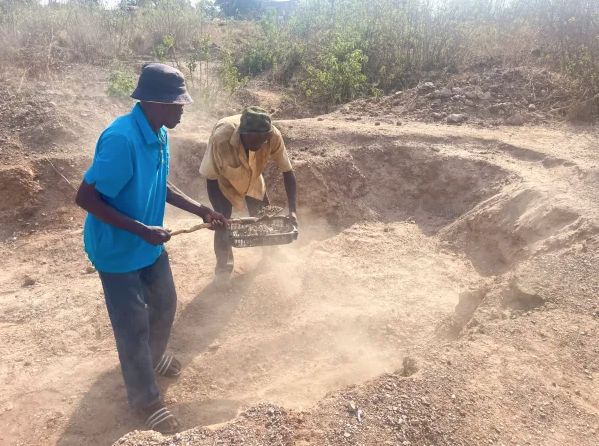
He rides a bicycle and insists we follow him at a distance until we reach the dusty hole where he and his companion, “Trevor” (both names changed to protect their identities), are working the tailings. They still have a little bit of work to do for the day, but they are scared of the other artisanal miners seeing us with them. “They can kill us,” Simon says nervously. “They don’t want anyone to see us working here, so even myself I’m at risk. If they saw me, they can kill me.”
He hacks at the hot, sunbaked material with his pick.
“We are digging lead here.” He picks up a rock and holds it out to me. “This is lead. It harms us; it makes us sick. But we have no work. We have to get something to eat, something to provide for our families. It’s hard work and it’s very dangerous to human beings.”
Simon has been doing this work since he was 19. He is 49 now.
“I have been seriously sick about three times. Last time I went for testing I was found sick with TB because of air pollution. There are times when you dig from up to down, and still find nothing. You have to return home empty handed. Sometimes a whole week goes by without finding anything. On a good day we make 1,000 Kwacha (about R700) – but 20 Kwacha ($0.77c) on a bad day. We get little money then, just enough to buy a small packet of maize meal.”
He looks around nervously before adding a few words about his four children.
“They get sick. Two of them were found with lead poisoning in their bodies.”
Simon and Trevor stuff the soil they have dug into a bag. They look at us uncertainly.
“We must go now,” they say.
Education
In the interview with MP Chrizoster Phiri Halwindi, she told me about how they were trying to educate people about the dangers of lead, and about how they are trying to develop programmes like farming to employ people.
I asked her about people like Simon and Trevor who have no farming skills, and, especially, no land.
“He can be trained in carpentry,” she replied.
But what can be done now, to stop him and his children being contaminated by lead?
She had no answer. I watched her eyes as she thought about it. There never has been an answer – and there is still none, at least for now. I respected the integrity of her silence.
After school we went back to where Diana and Sashi live in Magandayama township. The two of them, Sashi’s sister Gift, and Diana’s partner, Patrick, make do in a tiny room at the back of a small rundown church. A ragged, filthy curtain separates into two makeshift rooms. Battered plastic buckets of water and mealie meal are piled on top of one another next to a small, worn-out couch.
Diana feeds Sashi a couple of sweet biscuits and gives him a cup of water to drink. He is restless and irritable as she cuddles him and talks to me about her journey with Sashi and the pain she feels because she cannot ensure his health.
“He was tested at the community clinic. He was found positive with lead poisoning (in 2021). He was put on medication towards the end of April for two weeks. After that, he was given medicine for one week. At the hospital the medicine got finished. They told us they had run out of the medicine. Since 2021 my child has never been given any medicine. I am worried because the disease is progressing in my child.”
It would be wrong to say that the Zambian authorities are ignoring the situation. They are not, but with limited resources and capacity, not enough is being done for children like Sashi.
In December of 2023, the South Gauteng Division of the High Court in Johannesburg found in Anglo American’s favour, and denied the plaintiffs and their counsel certification to proceed with a class action suit. In the judgment, Justice Leonie Windell said: “The applicants seek permission to advance an untenable claim that would set a grave precedent.
“The precedent is that a business could be held liable half a century after its activities have ceased, to generations not yet born, as a result of being tested against future knowledge and standards unknown at the time.”
Leigh Day and Mbuyisa Molele filed for leave to appeal in January of this year, and it was granted on 19 April. They filed their notice with the Supreme Court of Appeal on 20 May 2024 and it is with the court.
The company has said that it will oppose this appeal.
This case cuts to the heart of what it means to be an African in the 21st century. It stands as a monument to the hundreds of years that companies have taken the continent’s rich resources and left the people who live around them with nothing, or worse, as in the case of Kabwe, with a crushing inheritance of generations of damage.
While the court battles rage, the children of Kabwe are left to fend for themselves. There can be no doubt that even while Anglo American may possibly win the legal battle and avoid direct responsibility, it has an unambiguous and deep moral culpability to provide restitution to the children of Kabwe, and to the adults that generations of them have grown into.
Legal and moral debt
There can be no doubt, too, that a number of Zambian officials over the past 50 years have failed the people of Kabwe. They, too, owe a legal and moral debt to those who have been left behind there. The necessary shifts of democracy mean that the original officials have long since been removed from power and responsibility in this matter, so the present government must find better ways to alleviate the situation.
But the poisoned heritage of suffering and crippling illness remains, bitterly undiminished by the passing of decades. Perhaps the courts will decide in the people’s favour, perhaps a new generation of Zambian leaders, with or without Anglo’s participation, will find some meaningful way to restore the environment of Kabwe and take care of the health of the people who live there.
In the low light of the setting sun, Diana has set up a tiny brazier outside in the dust. She has no kitchen, so this is where she prepares their bare evening meal – a piece of fish grilled on a few lumps of charcoal.
Before they eat, Diana pours some water over Sashi’s hands. When he is done washing them, he in turn takes the plastic jug from her and pours it over her hands. A moment of simple intimacy between mother and son, while Gift and Patrick wait their turn to wash their hands.
The family eat with little ceremony in the fading light of day, and Diana says: “My heart is very painful when I think about Sashi. I wish I knew what to do to create a better future for him.”
Stay informed with The Namibian – your source for credible journalism. Get in-depth reporting and opinions for
only N$85 a month. Invest in journalism, invest in democracy –
Subscribe Now!


